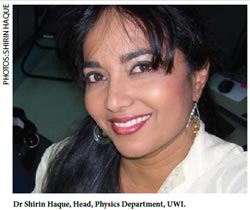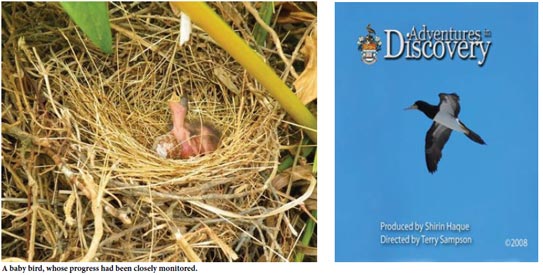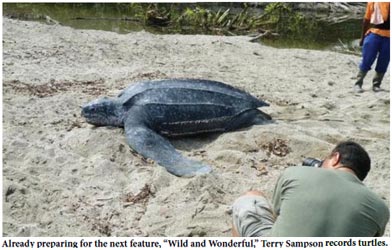
“All is Number,” is the second science documentary produced by Dr Shirin Haque and directed by Terry Sampson. A math appetizer is how Dr Haque describes this 22-minute feature recorded in Barbados and Trinidad and airing throughout the region. Dr Haque and Terry Sampson chatted with UWI Today about the process.
When did you first conceptualise the Caribbean Science Documentaries that resulted in 2008’s Adventures in Discovery?
SH: I remember it well - it was around October 2006 – I’d been feeling bored and missing challenges and then the idea of documentaries struck while I was watching one on science, and it consumed me. By July 2007, we had funding and were ready to begin filming. There were many failed attempts at fund-raising, numerous meetings and rejections, but I never gave up.
I have a real passion for science and television—together they are a potent combination to ignite the spark for spreading the good work of our science and our scientists. The Caribbean is known for its beaches and Carnival and Nobel Laureates in literature, but science had a gaping hole. I wanted to celebrate the spectrum of our scientists and their work. My strongest message was that it was all fun and an adventure. That was the motivation for “Adventures in Discovery.” Every scientist featured in that one was carefully selected to show our regional rainbow people and the relevance, value and importance of their work to our own people.

Having had the experience of creating a 25-minute documentary out of 22 days of filming in Trinidad, Antigua, Montserrat and Barbados, with a constantly growing budget, how did that shape your approach to the second project?
SH: It felt like back to square one with project number two: All is Number! This project was so different. The lesson I learnt was to listen to my director, Terry Sampson, a bit more. The last project proved that he knew what he was talking about. I learnt to appreciate the complexities and time involved (and cost) in recording a scene lasting one second on the screen. The second project reaffirmed that it does take a lot longer than anticipated and will always have cost overruns. But we never let it stop us—if you want something badly enough, you will find a way to make it happen, whatever it takes.
I must add the history of how “All is Number” happened. The folks at UWI Cave Hill Campus, Barbados were delighted at “Adventures in Discovery” and had supported it financially to include a segment on science in Barbados (“Caves and Canes”).
The proposal for a feature on Mathematics came from Prof. Leo Moseley of Cave Hill, who is a co-producer on this one, and he was instrumental in obtaining the major funding from the Peter Moores Trust in Barbados for it. Terry and I took it from there, developing the story line and treatment and doing all the research. This one was a year in the making as the challenges were totally different this time, and you must realize it was two persons doing it all part time!
What was the actual experience like?
SH: Absolutely phenomenal—the learning curve is steep—it was drowning myself in the interesting world of mathematics from a different angle, albeit an interesting one. It is addictive. Of the many interesting things I have done in my life, documentary production is at the top of the list. I wish I could do it for the rest of my life—and I have enough ideas to occupy me for such. But the limiting factor of course is the funding for such projects. So, I remain very grateful, starting with a wild card of an idea and a passion, with zero dollars, zero experience, that we are on our third feature currently (Wild and Wonderful). Thanks to Dr. Bhoendradatt Tewarie for taking a chance on us; and the continuing support of the Vice Chancellor, Principal, and Dean has been very motivating.
The next project that we currently have a glint in our eye about is “If things go Wrong,” a feature on the issue of food security in the region. Of course, starting with a budget of zero dollars never stopped us before!

What is “All is Number” about?”
SH: It takes the viewer on a journey into the world of mathematics through the lesser beaten path, and brings home the point that mathematics is all around us in things we do everyday that we are not consciously aware of. “All is number” was a statement made by Pythagoras, known as the father of mathematics. We show the role of mathematics in nature, the environment, electronics, climatology, medicine, music, architecture, art, economics, highlighting new areas of mathematics like fractals and chaos theory. We show how numbers are in all kinds of patterns everywhere. I could have produced an entire feature on each aspect alone. But this is an appetizer to the wonderful world of mathematics.
Who is it targeted at?
SH: General public and in particular at the level of high school and above. This feature is particularly suited for high schools and the Ministry of Education in Barbados has indicated that they would like to have both features in all their schools.
We were particularly delighted at the response of the television stations in Trinidad and Barbados who were very interested in the features and have aired it repeatedly. Caribbean Media Corporation (CMC) airs it regionally across the Caribbean and in parts of North America and has been a big supporter of the projects.
If you are interested in obtaining copies of the documentaries please contact Dr Shirin Haque at shirin.haque@sta.uwi.edu or 662-2002, ext. 2051. Both features will be posted on YouTube, with information on Facebook and Twitter as well.
|
TERRY’S TAKES
What was the most challenging aspect of filming this time around?
TS: The filming itself was not difficult. What was challenging was doing the time lapse for the flower buds opening, and creating the mood lighting for the music scenes.
With the previous experience, how did your approach change?
TS: I buffed up Shirin more! There is a huge gap sometimes between imagining what we would like to do and actually making it happen in terms of cost, equipment, technology and expertise. The two features were completely different videos so a comparison is difficult. The first was based on photography and videography and this new one “All is Number” is mostly based on post-production effects. A lot of the effects were subtly introduced into standing visuals so it would not overcome the viewer but enhance the points.
What was the best part of it for you?
TS: The completion (grinning)! A lot of different media was incorporated in this one—After Effects, Apple Motion, and we involved the Faculty of Engineering to generate the effects for the fractal move. Directing it, we had a lot more freedom. Developing the music, we incorporated cultural themes from an original score developed by Justin Sampson. This was entirely communicated through the internet and telephone!
Meeting the challenges with the graphics work was the best experience. This video through post production was a steep learning curve and an entirely different experience in trying to keep the budget down due to the graphics work.
|





